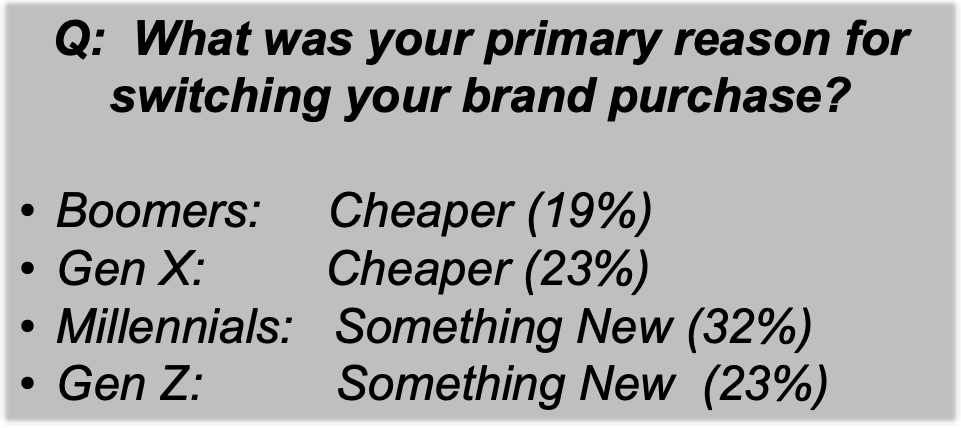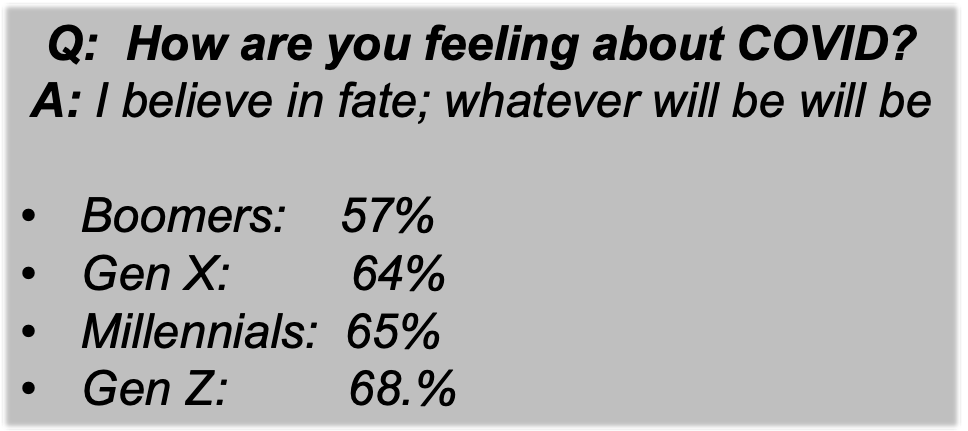The impact of Generation, Purpose & Store on shopping behavior.
By Theresa Lyons & Katie Butler, The Mars Agency
If you work in the marketing industry, you’ve no doubt seen this phrase more than once:
Right message. Right time. Right place.But the average adult makes 35,000 conscious decisions each day — 227 of them on food alone. So it’s no surprise to anyone that determining what message, time and place will actually be right is often elusive.
To complicate matters even more, shoppers don’t purchase your products the same way, at the same store, every time they shop your category. Because of shifting household dynamics, economic challenges and the pandemic’s impact on shopping behavior, your target audience is constantly evolving and rethinking their journey. The path to purchase has become fragmented and unpredictable, which means that it’s more essential than ever for marketers to make informed decisions.
At The Mars Agency, we use our Marilyn® technology platform to continuously monitor and understand the evolving shopping journey. Our most recent shopper survey analyzed 22,800 grocery trips across four trip types, 12 retailers and multiple channels including in-store, online, on-demand, delivery and curbside pickup fulfillment. The goal was to better understand current shopper behavior and uncover some of the significant changes that have taken place in how and where we can reach the target audience.
This article is the first in a series that seeks to help marketers navigate this evolving shopper journey. Throughout the series, we’ll focus on three core aspects of the journey that heavily influence behavior:
Generation: Generational dynamics have a significant impact on needs, influences and actions. We’ll look at key differences across Boomers, Gen X, Millennials and Gen Z.
Purpose: Shoppers can buy anywhere, anytime, so we’ll explore the dynamics affecting today’s various trip types.
Store: From online grocery retailers and on-demand platforms to physical locations, there are more format choices than ever. We’ll review how shoppers are selecting, shopping and behaving — not just at the biggest retailers, but at growth accounts as well.
We’ll start with the G: Generation.
As life stages evolve, so do shopper needs and behaviors. But have stereotypes led us to believe that Boomers are not digital, or that Gen Z only shops on mobile devices? Our survey identified some noteworthy differences across generations, but also some important commonalities. It also uncovered how the COVID-19 crisis has changed the shopping behavior of each generation compared to our last pre-pandemic survey in fall 2019.
Here are the five biggest aha’s that we found across Generations.
1. SEASONED SHOPPERS PLAN
How they plan the trip
There has been a lot of conversation over the last two years about impulse purchases — or the lack thereof, as the case may be. These days, your best chance for driving an impulse purchase (regardless of category) may be with Millennials and Gen Z, as they’re less likely to prepare for their trip and more likely to want an easy “in and out” store experience. On the contrary, Boomers and Gen X are more likely than the younger generations to plan the trip and be in less of a hurry while shopping.

Implication: Given their limited planning and desire to get things done quickly, Millennials and Gen Z may make some hastier decisions and be easily swayed if you can get appealing solutions in front of them at the right time in their path to purchase. If you’re targeting Boomers and Gen X, focus your inspiration or education efforts on the planning stage, when they’re more methodical about decision making.

2. EMOTIONS GUIDE ACTIONS
How they feel about their trip
As mentioned, Boomers and Gen X are planners, which can make them very task-oriented when it comes to grocery shopping. The emotions they apply across their paths to purchase are confident, focused and efficient. Millennials are quite a bit different, identifying such emotions as excited, happy and satisfied — which suggests that they might even find grocery shopping enjoyable. But what’s most notable about Millennials is the shift in their emotions since the pandemic: They reported little happiness or excitement in their stock-up trips previously, and instead indicated more task-oriented emotions like focused, efficient and satisfied. (The only hint of happiness came when they completed the trip) Meanwhile, Gen Z exhibits a blend of emotions, starting and ending their trips happy and excited but focused firmly on the task of shopping in between.

Implication: Purchases are emotional in nature and It’s important to take these emotions into consideration. If Boomers and Gen X are focused and efficient, they‘ll appreciate assistance in getting the task done. How can you help them plan and shop as efficiently as possible? Or disrupt their trip with something memorable and exciting.For Millennials, the shift in emotions from focused to excitement could be that their use of curbside pick up and delivery is saving them time or that they are feeling more comfortable in the store again, both of which may make them more willing to explore. So how can you inspire them? With Gen Z, identify the emotion your product best aligns with and consider that as you determine where to intercept their trip.
Millennial Emotions, 2021

Millennial Emotions, 2019

3. EXPERIENCE MOTIVATES EVERYONE
How they choose where to shop
Across the generations, where they choose to shop is based on the experience itself, with good customer service, the ability to find everything in one place and favorable ratings & reviews among the top criteria for retailer selection. Among the most notable changes since our 2019 survey is that store proximity has dropped from being one of the most important to one of the least important factors among Millennial and Gen Z shoppers. Why? As these generations shift to curbside pickup and delivery for their stock-up grocery trips, distance may simply be less important or, in the case of delivery, altogether irrelevant.

Implication: The bar is being raised. Shoppers may have prioritized the convenience of nearby retailer in the past, but they now want more. Look at the shopping experience from the shopper’s vantage point: Is it easy to explore, especially online? Given the ongoing supply chain challenges, can they find what they need?With staffing shortages impacting brick-and-mortar, is customer service still good? Pay close attention to these attributes that are now driving choice with shoppers.

4. WITH AGE COMES INDEPENDENCE
Who they shop with
The people we shop with are “influencers” who affect and alter the choices we make and the items and brands we buy. Both Boomers and Gen X are more likely to shop alone, so appealing to their personal needs and preferences will be the most compelling way to reach them. In comparison, Millennials are very likely to have their children or spouse in tow, so framing solutions with family appeal will be important for capturing their attention. Gen Z, in contrast, is most likely to shop with a parent or other family member; that makes it a toss-up over whether they’re influencing the household purchases someone else is making, or they’re using their own disposable income to do the buying that other family members are influencing.

Implication: We very often look to famous influencers to drive consideration, but we often forget about the people who can more closely and directly influence purchases week in and week out. Whether the shopping trip is online or in-store, it’s important to think about how the shopper’s most important influencers — their family members — are impacting purchases.

5. DEALS FOR ALL, INSPIRATION FOR SOME
What happens during the trip
Commonalities during the shopping trip across all generations are the use of navigational tools (both in-store and online) as well as a desire for deals and promotions. All generations are also all more willing to remove items from their digital shopping cart than from their physical cart in the store.
But they also have their differences, of course.
Boomers and Gen X are more likely during a trip to be reminded about something they forgot to put on the list, and also to look at a product’s ingredient list. These generations are more methodical about trip planning, and their shopping behavior reflects that.
Millennials and Gen Z are more likely to be in exploration mode, looking for something new in-store and using special offers for inspiration online. Remember that these generations are less likely to plan their trips, so they rely more on the shopping environment to guide their choices.

Implication: Through these behaviors, Boomers and Gen X reinforce their thoughtful shopping nature. Consider ways to become a trusted source that they’ll rely on, whether through recipes, list making assistance, or education about products and categories. Meanwhile, Millennials and Gen Z provide all kinds of opportunities to inspire and generate trial. Appeal to their desire for something new and interesting by helping them understand the unique benefits of your products.

As marketers, we focus on the shopper our brands are targeting. But when you compare that shopper to other generations or audience segments, it can enlighten you to behaviors that previously may have looked ordinary to you. It also can be extremely informative to look beyond the actual path to purchase for your product and examine all the dynamics around the trip, such as shopper emotions and who they’re shopping with, to develop a well-rounded view of everything that might be influencing choice.

About the Authors
Theresa Lyons, SVP-Strategic Planning
Theresa has been with The Mars Agency for 26 years and currently leads a team of 12 diverse strategists dedicated to developing a deep understanding of the “why” behind shopper behavior to deliver insights and strategy that build brands. Theresa has helped develop shopper strategy for many of the agency’s new business wins, as well as for some of its key clients including Campbell Soup, Henkel, Conagra Brands, BlueTriton, Bacardi and Mars Wrigley. She also has been a key contributor to the development and deployment of our breakthrough Marilyn ® technology. Reach her at [email protected].

Katie Butler, VP-Strategic Planning
Katie’s career has touched many areas of marketing, including broadcast producer, concept director and ECD. All roads have led her to where she belongs, her current role in planning.
Katie loves the shopper and retail space, having spent most of her career building consumer promotions and shopper programs for iconic companies with brands found in the pantries, freezers and cupboards of most households, including Nestlé, Kimberly-Clark, Johnson & Johnson, Campbell Soup and SC Johnson.



